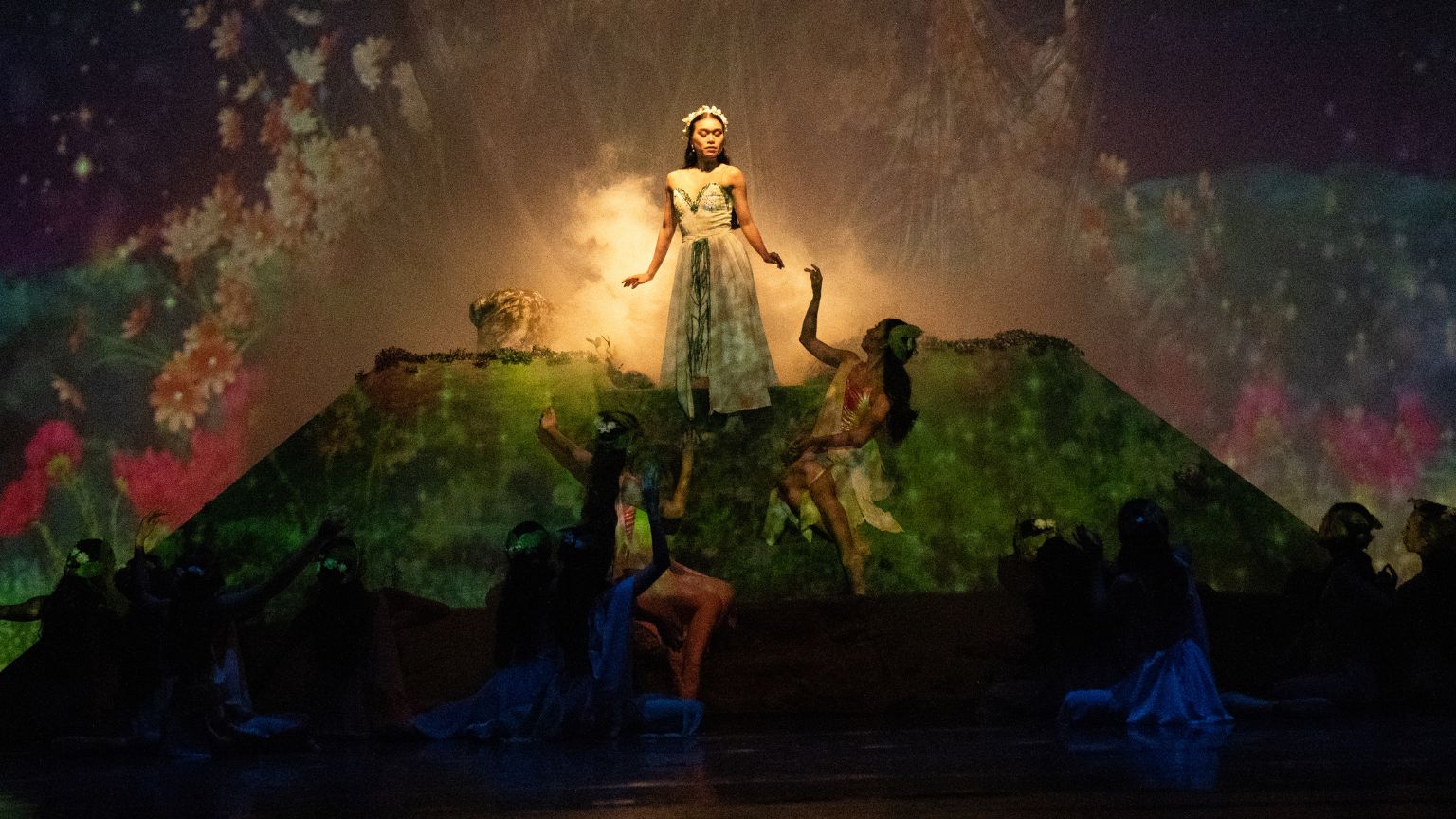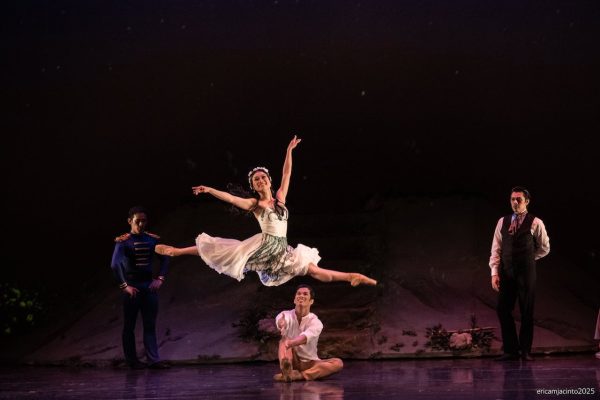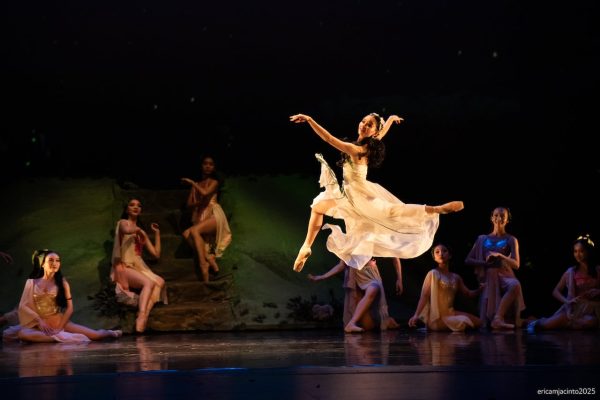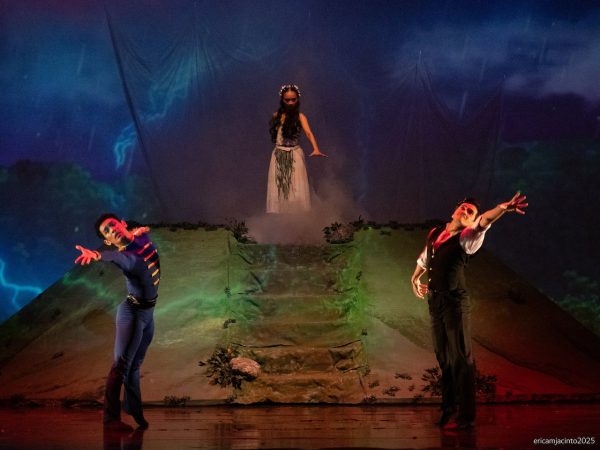
REVIEW: PBT’s Maria Makiling Revisits a Folk Legend with Mixed Results
Philippine Ballet Theatre (PBT) opened its 39th season with Maria Makiling, a retelling of the guardian spirit of Mount Makiling. Artistic director Ronilo Jaynario drew inspiration from his roots as a graduate of the Philippine High School for the Arts (PHSA), nestled at the foot of the famous mountain, where stories of Maria Makiling’s unseen vigilance and environmental guardianship are woven into local folklore.
The ballet opened with villagers from Laguna preparing for a harvest celebration when a woman suddenly fell ill. The community pleaded to the unseen spirit of Maria Makiling, but no striking visual cue or theatrical device ever confirmed her mystical presence, leaving the audience waiting for a more powerful manifestation.
More peasant dances followed, highlighted by a lively Maglalatik, a traditional combat dance from Laguna where male dancers rhythmically clashed coconut shells strapped to their bodies. Jaynario’s choreography layered this folk piece with balletic flair—scissor grand jetés, pas de chat en tournant (leaps resembling a cat’s spring with an airborne turn), aerial turns, armless cartwheels, and pirouettes with extended legs. Though technique was uneven, the rustic character of the peasants allowed some of the roughness to pass, and the energy of the dance charmed the audience.
Maria Makiling was then courted by three suitors: Juan, the humble farmer (alternately danced by Justine Orande and Matthew Davo); Captain Santiago of the guardia civil (Dominador Delmo); and Emilio, the ilustrado (alternately Ace Polias and Jimmy Lumba). Each danced for Maria, but while the Captain and Emilio displayed cocky bravado, Juan’s tender, reverent approach touched her heart. When Maria vanished into the mountains, however, the sudden shift to a lighthearted, lyrical ensemble dance felt tonally inconsistent, especially given the looming tragedy.

L-R: Dominador Delmo, Jessa Tangalin, Justine Orande, Jimmy Lumba; Photo Credit: Erica Feliz Marquez-Jacinto
In the following scenes, both Captain Santiago and Emilio, spurned and resentful, desecrated the mountain—one carelessly discarding a cigarette, the other tossing refuse—gestures meant to symbolize environmental neglect. Unfortunately, with both dancers facing upstage, the impact of this moment was diminished. The Captain’s torch soon set fire to the town’s cuartel, and when the guardia civil investigated the blaze, the rejected suitors framed the innocent Juan. Yet the choreography failed to convey how the villains pressured the townspeople into supporting the false accusations. Flawed staging undermined the climax: Juan was executed while the villagers, illogically placed within the line of fire, stood by.
Maria Makiling’s anguished return triggered a thunderstorm—represented by stage effects. She is reunited with Juan’s spirit and the two disappeared into the mist. In the ballet’s final moments, the townspeople made offerings at the mountain’s foot, closing the story with a ritual of renewal.
Jaynario, a longtime choreographer trusted by PBT’s Artistic Council, is known for creating lavish story ballets. Yet his post-pandemic works revealed a tendency toward formula: a love triangle, a clear-cut villain—or two—and a series of divertissements, ensemble dances that charm with technical display but often stall narrative momentum.
The plot offered little room for the dancers to explore or deepen their characters. The choreography, his signature blend of classical ballet, contemporary movement, and Filipino folk dance, provided color but rarely moved beyond surface-level storytelling.
Throughout the ballet, the stage was crowded with group dances—each performed with earnest energy but arranged in predictable linear formations with only slight variations. Without a clear logic to how the dances progressed or how they connected to the emotional arc of the story, the sequences began to blur into repetition. The choreography gave the dancers steps to execute, but little to embody.
Despite PBT’s commitment to producing story ballets, the performance showed that not enough time had been devoted to coaching the dancers in character development. Many fell into the so-called tawa at iyak style of acting—relying on overstated expressions rather than true internalization. Their performances raised unsettling questions: Did they understand their characters’ motivations? Did they know why they danced beyond the demands of looking graceful?
One wondered, too, whether this lack of depth reflected a broader cultural reluctance: a hesitancy to challenge the choreographer’s vision, or a fear of overstepping by asking difficult artistic questions. Or perhaps the dancers sensed that even if they asked, there might not be satisfying answers.
In folklore, Maria Makiling is often portrayed as an avenger and punisher, meting out swift and supernatural justice to those who harm her sacred mountain. In José Rizal’s telling, however, she emerges as a sorrowful, withdrawn figure—her silent disappearance serving as the ultimate rebuke to a society corrupted by greed.
The duality of these interpretations played out in the casting. Jessa Tangalin, in the title role, embodied the folkloric mountain goddess—earthy, imperious, with a fierce intensity that suggested an elemental force of nature. A natural choice for the role, Tangalin is an alumna of the PHSA, where the myth of Maria Makiling hovers as living folklore. She has quietly built a reputation in the dance and theater community for her grounded artistry, and when she moves, the laws of physics seem firmly on her side. Longtime followers of her career have seen her pay her dues—through Ballet Philippines, Alice Reyes Dance Philippines, and now PBT—emerging as one of the few dancers in the company capable of both dramatic nuance and technical clarity.
By contrast, Gabrielle “Gabbie” Jaynario, the alternate Maria, appeared to draw from Rizal’s more fragile, melancholic vision of the character. With her delicate frame, she may not be the best fit for the wildness of the wilderness goddess, but she compensated with a luminous expressiveness, particularly in her upper body and port de bras. In just one season, she has been vaulted into lead roles—a meteoric rise in the dance world where such ascents typically take years, if not decades.

Gabbie Jaynario as Maria Makiling; Photo Credit: Erica Feliz Marquez-Jacinto
Gabbie’s growth as an artist is undeniable: she danced with more daring, greater theatricality, and an instinct for mesmerizing an audience. Her pliant upper body made her particularly suited for contemporary choreography. Yet the demands of classical ballet revealed the limits of her technique. Her core strength and stamina slackened as the ballet progressed as her muscles stopped firing, her legs dropped, and her feet failed to fully stretch through the pointe. In moments of heightened emotion, she veered toward overacting—exaggerated facial expressions that might impress some, but lacked the internal depth to truly convince.
The difference between the two alternating dancers became most apparent in their turns. Tangalin executed her arabesque pirouettes and supported pirouettes with control, balance, and clean placement. Each rotation was measured and centered. Gabbie, while able to match the number of rotations, often blurred the line between turning and spinning, sacrificing precision for momentum. Her supported pirouettes were not always centered, lacking the command that separates competence from mastery.
It raised inevitable questions—why was the stronger, more seasoned pair of Tangalin and Justin Orande given only a single matinee, while the gala and a second show went to Gabbie and Matthew Davo, whose performances, though earnest, relied on exaggerated theatrics rather than refined technique? There are always the “mysteries” of casting, of course—artistic prerogative or the grooming of new stars—but it left some in the audience wondering whether more deserving dancers were being overlooked in favor of fast-tracked favorites.
As Juan, Justine Orande once again stood out for his clean technique, though he has yet to be given a role that truly stretches his dramatic range. Matthew Davo, by contrast, danced with palpable energy, but after several years in leading roles, one hoped for greater maturity. His performance, while technically serviceable, lacked emotional depth; he moved through the choreography with a fixed expression, leaving his Juan curiously hollow and disconnected from the unfolding tragedy.
Among the men, Dominador Delmo left the most lasting impression. His smooth, controlled turns, buoyant jumps that landed like a cat’s, and stage presence elevated every scene he entered. Meanwhile, Ace Polias and Jimmy Lumba delivered crisp, precise interpretations of Emilio, the ilustrado, performing with an understated elegance that served the role well.

L-R: Dominador Delmo, Gabbie Jaynario, Ace Polias; Photo Credit: Erica Feliz Marquez-Jacinto
One of the evening’s quieter highlights came from Gladys Baybayan and Julafer Fegarido, who danced a heartfelt pas de deux as villagers appealing to Maria Makiling for help. Their partnering was efficient and emotionally restrained—a moment that could have easily gone unnoticed but gave the narrative a human touch. Both are seasoned dancers whose contributions deserved more recognition; inexplicably, their names were left out of the souvenir program, an unfortunate oversight that failed to acknowledge their artistry.
There has been a noticeable improvement in the company’s technical development, particularly in jumps and pirouettes, thanks to the guidance of longtime ballet master Anatoli Panasiukov. The energy in both performances was high, and the audience responded enthusiastically, breaking into applause each time a dancer successfully executed multiple pirouettes. The cheers during the curtain calls were equally effusive, reflecting the warmth and goodwill of the crowd.
The production benefited from thoughtful set design by Rene Cubar, with a particularly clever transformation from the slopes of Mount Makiling to the church and belfry. Digital animations and special effects by Enrico Navarro and former basketball icon Fortunato Co added visual flair, though at times the effects bordered on excess. With stronger integration between choreography and visuals, the production could have drawn sharper focus to Maria Makiling’s deep connection to nature. The lighting design by Louie Alcoran, though ambitious, faltered in execution—exposed floodlights distracted the eye when they should have been hidden from view.
Maria Makiling marks Jaynario’s third foray into folkloric ballet in collaboration with composer Paulo Zarate, following Ibalon and Sarimanok, both of which were remembered for excess. This latest work felt tighter and more considered, the result of Jayanario’s research. Zarate’s music continues to evolve alongside the storytelling, weaving recurring motifs and thematic variations that give the ballet coherence and emotional texture. His background in popular music makes his compositions accessible even to audiences unfamiliar with ballet, offering an aural bridge between classical and contemporary sensibilities.
In the end, Maria Makiling showcased a company in transition—full of promise, striving for artistic growth, and cheered on by an audience eager to see them succeed.
Tickets: Php360.5 – P2500
Show Dates: July 5-6 2025
Venue: Samsung Performing Arts Theater
Running Time: approximately 1 hour and 20 minutes (with a 15-minute intermission)
Creatives: Ronilo Jaynario (artistic director), Paulo Zarate (composer), Anatoly Panasyukov (ballet master), Louis Alcoran (technical director and lighting designer), Enrico Navarro and Fortunato Co (animator and special effects and creative design), Rene Cubar (set execution)
Featured Cast: Gabrielle Jaynario/ Jessa Tangalin (Maria Makiling), Matthew Davo/ Justine Orande (Juan), Dominador Delmo (Captain Santiago), Ace Polias/ Jimmy Lumba (Emilio)


Comments